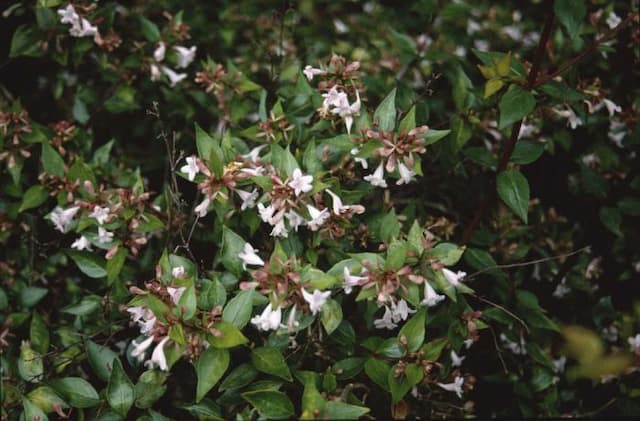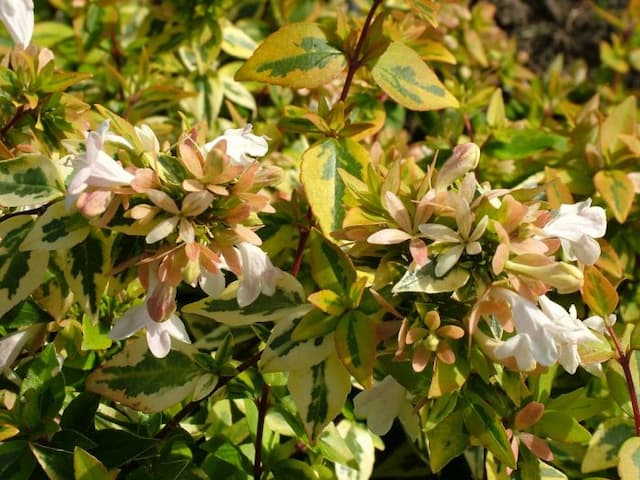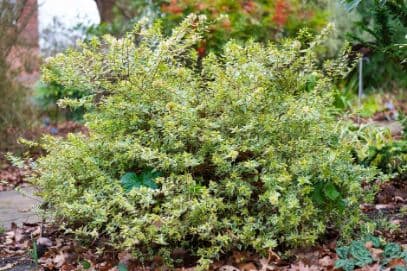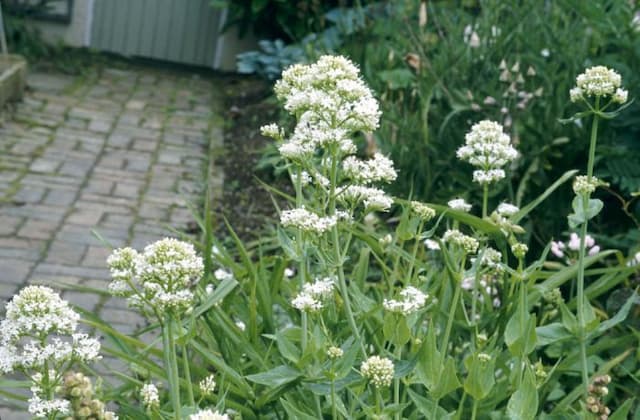Italian Honeysuckle Lonicera caprifolium

ABOUT
The Lonicera caprifolium, commonly known as Italian honeysuckle, is a vigorous and beautifully ornamental plant. It features long, twining vines that grasp onto structures and other plants with a determined cling. The leaves are simple and opposite, often oval-shaped with a visibly pointed tip, and they possess a lush, green hue that can vary from light to deep tones. One of the most striking aspects of Italian honeysuckle is its blossoms. The flowers are produced in pairs and are tubular in form, extending from the center of a shared, leafy bract. These blossoms are a fetching combination of cream, pink, and yellow hues, creating a subtle but inviting palette. They unfurl to expose delicate lobes, which occasionally bear a resemblance to tiny trumpets, and are known for their sweet, intoxicating fragrance that becomes especially prominent during the evening. After the flowering period, Italian honeysuckle produces translucent red or orange berries, which can offer a visual treat and attract various forms of wildlife. Yet, it is the plant's overall elegant form and its cascades of alluring flowers that make the Italian honeysuckle a popular choice for gardens and landscapes, providing a picturesque display when allowed to climb over trellises, fences, and walls.
About this plant
 Names
NamesFamily
Caprifoliaceae.
Synonyms
Italian Woodbine, Perfoliate Woodbine, Goat-Leaf Honeysuckle, Late Dutch Honeysuckle, Evergreen Honeysuckle.
Common names
Caprifolium odoratum, Caprifolium perfoliatum, Lonicera brachypoda, Lonicera lutea, Lonicera italica, Lonicera perfoliata, Periclymenum caprifolium, Periclymenum italica, Periclymenum perfoliatum.
 Toxicity
ToxicityTo humans
Italian honeysuckle (Lonicera caprifolium) is generally not considered highly toxic to humans, but it may cause mild symptoms if ingested. Like many ornamentals, certain parts of the plant, such as berries, can be potentially harmful. If ingested, symptoms may include stomach upset, diarrhea, and vomiting. It is advisable to keep an eye on children and educate them not to consume parts of ornamental plants due to potential risks.
To pets
Italian honeysuckle (Lonicera caprifolium) carries a risk of poisoning for pets, particularly if they consume a significant amount of the plant. The berries are especially concerning and can cause gastrointestinal upset if ingested by pets, leading to symptoms such as vomiting and diarrhea. While it is not typically considered one of the most toxic plants to pets, it is still a good practice to prevent access to any part of the plant to avoid potential health issues.
 Characteristics
CharacteristicsLife cycle
Perennials
Foliage type
Deciduous
Color of leaves
Green
Flower color
White
Height
20 feet (6 meters)
Spread
10 feet (3 meters)
Plant type
Climber
Hardiness zones
5
Native area
Europe
Benefits
 General Benefits
General Benefits- Attracts Pollinators: Lonicera caprifolium, commonly known as Italian honeysuckle, is known for its fragrant flowers, which attract bees, butterflies, and other pollinating insects, supporting local ecosystems.
- Ornamental Value: With its attractive, tubular flowers and ability to climb, Italian honeysuckle can be used in gardens and landscapes for aesthetic purposes to enhance visual appeal.
- Habitat for Wildlife: The dense foliage and flowers provide shelter and nesting sites for birds and other wildlife, contributing to biodiversity.
- Erosion Control: Its vigorous growth habit and root system can help stabilize soil, preventing erosion on slopes and banks.
- Fragrance: The sweet-smelling blooms can add a pleasant fragrance to gardens and outdoor spaces, enhancing the sensory experience.
- Screening Plant: Its quick growth and dense habit make it suitable for use as a natural privacy screen or to hide unsightly areas.
- Ease of Care: Italian honeysuckle is generally a low-maintenance plant, requiring minimal care once established, making it popular among gardeners of all skill levels.
 Medical Properties
Medical Properties- Antibacterial: Lonicera caprifolium, commonly known as Italian honeysuckle or perfoliate honeysuckle, has been traditionally used for its potential antibacterial properties.
- Anti-inflammatory: The plant has been used in traditional medicine for its possible anti-inflammatory effects, particularly in the treatment of sore throat and swollen glands.
- Antiviral: Some research suggests that compounds in Italian honeysuckle may have antiviral benefits, using for infections like influenza.
- Diuretic: Italian honeysuckle has been used as a diuretic to help increase urine production and relieve fluid retention.
- Expectorant: The plant has been used to aid in the expulsion of mucus from the airways and is sometimes used in remedies for respiratory tract infections.
- Sedative: There is evidence that it has been used in traditional medicine for its mild sedative properties to help reduce anxiety and promote sleep.
 Air-purifying Qualities
Air-purifying QualitiesThis plant is not specifically known for air purifying qualities.
 Other Uses
Other Uses- Lonicera caprifolium, commonly known as Italian honeysuckle, can be used as a natural fencing material when grown over trellises, providing a densely woven structure that offers privacy and beauty.
- The flowers of the Italian honeysuckle are sometimes used in the perfume industry due to their sweet and pleasant fragrance.
- The vines of Italian honeysuckle can be dried and woven into baskets and other artistic craft items, showcasing its versatility beyond the garden.
- Due to its rapid growth and attractive appearance, Italian honeysuckle can be used as a landscaping plant to cover unsightly structures or bare patches in a garden setting.
- Italian honeysuckle can be trained to grow along cables or strings to create living curtains or green room dividers in outdoor spaces.
- The plant's ability to climb aggressively makes it suitable for use in topiaries and living sculptures, where it can be shaped and maintained to complement garden designs.
- In rural areas, Italian honeysuckle might serve as a source of forage or shelter for wildlife, including birds and beneficial insects.
- Cultivated varieties of Italian honeysuckle with particular flower colors can be utilized for themed garden designs, such as moon gardens with white blooms that reflect moonlight.
- Italian honeysuckle's dense growth habit can be used to prevent soil erosion on slopes or banks, helping to stabilize the soil with its root system.
- The nectar within Italian honeysuckle flowers could be harvested and used in the culinary field as a sweetening agent, though this practice is not commonly done.
Interesting Facts
 Feng Shui
Feng ShuiThe Italian honeysuckle is not used in Feng Shui practice.
 Zodiac Sign Compitability
Zodiac Sign CompitabilityThe Italian honeysuckle is not used in astrology practice.
 Plant Symbolism
Plant Symbolism- Love: Lonicera caprifolium, commonly known as honeysuckle, often symbolizes love and the generous affection towards others due to its sweet scent and ability to attract hummingbirds and butterflies, suggesting an allure that's difficult to resist.
- Devotion: The way honeysuckle plants cling to their supporting structures can represent the clinging nature of love, symbolizing devotion and the everlasting bonds between people.
- Generosity: Honeysuckle's abundant nectar represents generosity and giving, making it a symbol of selflessness and the act of providing for others.
- Bonds of Love: The intertwining vines of the honeysuckle suggest the tight bonds in a loving relationship, often reflecting how two lives can become intricately connected.
- Protection: Some traditions hold that honeysuckle has protective qualities, symbolizing a safe haven or a sanctuary, as it has been believed to ward off evil spirits when grown near the home.
- Happiness: With its sweet-smelling flowers, honeysuckle is also seen as a bearer of joy and happiness, evoking pleasant feelings and the sweetness of life.
 Water
WaterItalian Honeysuckle should be watered when the top inch of soil feels dry to the touch, which will typically be about once a week, depending on environmental conditions. During the growing season, provide deep watering to encourage root growth, which might mean using approximately 1 to 2 gallons of water every week for outdoor plants. Reduce frequency in the winter when the plant's water requirements decrease. Always water at the base of the plant to avoid wetting the foliage, which can lead to fungal diseases.
 Light
LightItalian Honeysuckle thrives in full sun to partial shade. The ideal spot for this plant is where it can receive at least 6 hours of direct sunlight per day, but it can also tolerate some shade, especially during the hottest part of the day. Avoid overly shaded areas as this can lead to reduced flowering and a leggy growth habit.
 Temperature
TemperatureItalian Honeysuckle can tolerate a wide range of temperatures, but the ideal conditions are between 60°F and 80°F. It's hardy in USDA zones 4 through 9, which means it can withstand minimum winter temperatures down to about -20°F. During extreme summer heat, providing adequate water can help the plant maintain its health.
 Pruning
PruningPrune Italian Honeysuckle after flowering to maintain shape and encourage vigorous growth. This plant can be pruned up to two to three times per year, depending on growth rate and desired form. The best time for heavy pruning is late winter or early spring before new growth starts, though light trimming can occur after each flowering period.
 Cleaning
CleaningAs needed
 Soil
SoilItalian Honeysuckle thrives in a well-draining soil mix with a pH of around 6.0 to 7.5. A mix containing loam, peat, and perlite is ideal for balance and drainage.
 Repotting
RepottingItalian Honeysuckle should be repotted every 2-3 years to refresh the soil and accommodate root growth.
 Humidity & Misting
Humidity & MistingItalian Honeysuckle prefers moderate humidity but is adaptable to different humidity levels as long as soil moisture is adequate.
 Suitable locations
Suitable locationsIndoor
Ensure bright indirect light and adequate space for vines.
Outdoor
Provide support for climbing, full sun to partial shade.
Hardiness zone
4-9 USDA
 Life cycle
Life cycleItalian honeysuckle (Lonicera caprifolium) begins its life cycle as a seed, typically germinating in spring under suitable temperature and soil moisture conditions. Upon germination, the seedling grows and develops into a juvenile plant, establishing a root system and beginning to vine. As it matures, Italian honeysuckle extends its vines, using other plants or structures for support, and develops its characteristic foliage. In late spring to summer, the plant reaches the flowering stage, producing fragrant, tubular white to yellowish flowers that are attractive to pollinators like bees and hummingbirds. Following pollination, the flowers develop into small red to black berries, which contain seeds that are dispersed by birds and other animals. The plant can also spread vegetatively through layering, where stems in contact with the soil root to form new plants, ensuring the continuous growth and expansion of the honeysuckle in its environment.
 Propogation
PropogationPropogation time
Spring-Early Summer
Propogation: The most popular method of propagation for Lonicera caprifolium, commonly known as Italian honeysuckle, is through semi-hardwood cuttings. This is typically performed in late summer. Cuttings about 6 inches (15 cm) long are selected from healthy, disease-free parent plants. The lower leaves are removed, and the cut end is often dipped in rooting hormone to encourage growth. The cutting is then planted in a well-draining potting mix and kept moist until roots have developed, which generally takes a few weeks to a couple of months. Once established, the rooted cuttings can be transplanted to their final location in the garden.









